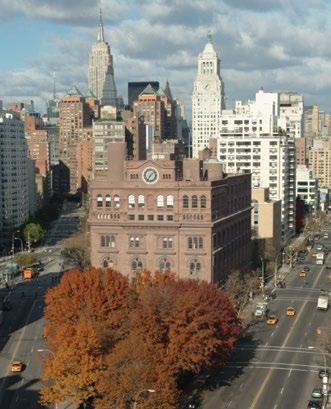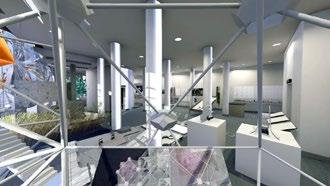
6 minute read
The Cooper Union Irwin S. Chanin School of Architecture
THE IRWIN S. CHANIN SCHOOL OF ARCHITECTURE OF THE COOPER UNION Cooper Square 7 East 7 Street New York, NY 10003 212.353.4220 cooper.edu
Nader Tehrani, Dean
Student Faculty Ratio: 5:1
Tuition & Fees: $44.550/Year * Every undergraduate student receives a 50%-tuition scholarship of $22,275
Number of Students: 150
Application Deadlines: 1/ 1
Type of Campus: Urban
The Foundation Building, Photo Credit: Leo Sorel
The mission of The Irwin S. Chanin School of Architecture is to provide for its students the finest professional education available within an intellectual environment that fosters and expands their creative capacities and sensibilities and establishes the foundation for a productive and creative professional life. The school is committed to the belief that one of society’s prime responsibilities is toward learning and education in the deepest sense: that the exercise of individual creativity within a willing community is a profoundly social act. Fundamental to the mission of the school is the maintenance of a creative environment in which freedom of thought and exploration can flourish and where students can explore and utilize their individual talents, interests and modes of working to their highest potential.
PROGRAMS
THE BACHELOR OF ARCHITECTURE
curriculum of the School of Architecture is designed to provide the student with a comprehensive educational experience, gaining knowledge and skills in preparation for the successful and ethical practice of architecture. Design studios and courses build cumulatively over the five years in order to establish a broad and deep foundation of knowledge in architecture and urban design in relation to developments in the sciences, arts, and technology. The curriculum stresses the importance of architecture as a humanistic discipline concerned with the design and construction of habitats in diverse social and ecological conditions, and their corresponding requirements for sustainability and ethical responsibility. The traditional and essential skills of drawing, model-making and design development are complemented by a full investigation of the analytical and critical uses of digital technologies. The study of world architecture and urbanism is deepened by the understanding of individual cultures, environmental, and technological issues at every scale. The theory of the discipline, past and present, is investigated through the close analysis of critical texts and related to the theory and practice of other arts, such as public art, film and video. The position of the School of Architecture, together with the Schools of Art and Engineering and the Faculty of Humanities and Social Sciences, offers a unique opportunity for interaction and interdisciplinary research and experience.
In recent years the school has developed the studio curriculum in ways that have reinforced its strong traditions of design and craft while investigating problems that reflect the changing conditions of contemporary practice, the urgent issues resulting from rapid urbanization and the need for environmental and cultural conservation. In these studio experiments students and faculty together explore the potential contributions of architecture to our changing world, redoubling their efforts to imagine a positive future for an architecture that is, after all, a discipline of design. This task does not involve a wholesale rejection of the past – our traditions and historical experience – for what has changed are not the principles, but rather the determinants and the materials of design. We are in the process of re-learning the poetics of a space of life: of air and water, of geology and geography, of culture and society, of poetics that lie deeply within these elemental forces. On this re-framing – programmatically, technologically, and above all formally – rests not simply the future of architecture,

2020 Virtual End of Year Show – Thesis
but of our life in the world. Gradually, out of this process, architecture, once more, may become a force through which life is transcribed into art in order to enhance life. The five year professional program is framed within the context of a rigorous liberal arts education that includes a wide range of required and elective courses in the Humanities and Social Sciences, together with elective opportunities in the Schools of Art and Engineering, emphasizing the nature of architecture as a cultural, social, and technological practice intimately tied to the increasingly urgent questions raised by the man-made and natural environment.
THE MASTER OF SCIENCE IN ARCHITECTURE
The Master of Science in Architecture post-professional degree program was launched in 2009 to extend the vision and intellectual rigor of the undergraduate program and allow a further development of the school’s preeminent position in the education of architects. It is open to applicants with a first professional degree in architecture (Bachelor of Architecture or Master of Architecture I) from a program accredited by the NAAB or equivalent accrediting agency in another country. While the Master of Science in Architecture program is studio based, concentrations in one or a combination of three areas are offered: theory, history and criticism of architecture, urban studies and technologies.

2019 End of Year Show – Design IV
The school’s faculty includes many figures eminent in architectural design, theory, and scholarly research that bring distinction to the school. The full time and proportional time faculty provide continuity while the many adjunct and visiting faculty allow for additional views

Spring 2019 Final Review – Architectonics
and concepts that enrich the program and allow it to respond to the rapidly changing contemporary conditions of practice. The Shop is integral to both the program and pedagogy of the School of Architecture. Shared with the School of Art, it is equipped for projects in wood, metal, plastics, plaster and clay, and includes a bronze casting foundry. Digital facilities throughout The Cooper Union support a design curriculum that recognizes the use of digital technologies as instruments of practice, research and design. Students are urged to explore the full formal, philosophical and cultural implications of computational design and fabrication in architecture. The Cooper Union Library offers a wealth of books and periodicals, visual and historic materials, access to a wide variety of electronic resources as well as DVDs, videotapes, 16mm films, digital images, slides, maps and blueprints. The Cooper Union Library is a member of a consortium of academic libraries which includes room use and borrowing privileges at New York University’s Bobst Library and the libraries of the New School University. The spirit of the design studio informs and permeates the entire school, and students value its intensity. In the studios and shops, students work together as a community of individuals, openly sharing and exchanging information, ideas and creative work; in this way a unique environment of cross fertilization between classes and individual students is fostered and maintained.
Admission to the program is based solely on merit. The application deadline is January 1 for freshmen and transfer students. Applicants must complete a STUDIO TEST as part of the application process. More detailed information can be found on The Cooper Union website, http://cooper.edu/. All inquiries should be directed to the Office of Admissions and Records, 30 Cooper Square, New York, NY 10003, email: admissions@cooper.edu.

Spring 2019 Final Review – Thesis








